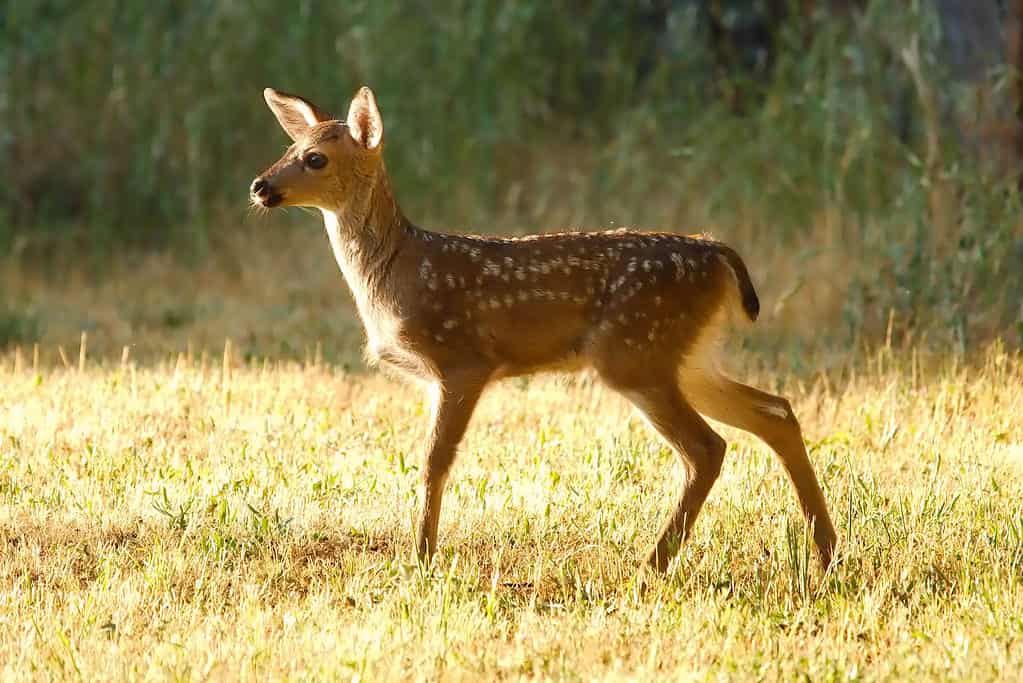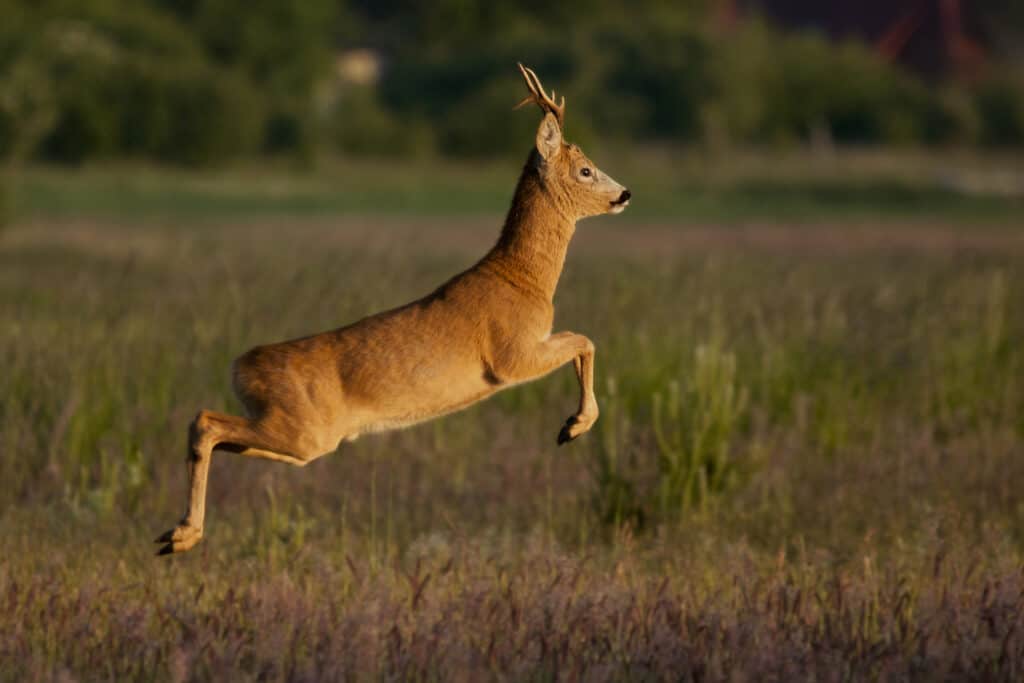If you’ve ever wondered how high deer can jump, you’re definitely not alone. These majestic creatures are lightning-fast and excellent at escaping danger with their long, powerful legs. But just how high can they jump? Could they clear a human being? Let’s take a look at the answer (and more!) below.
How High Can Deer Jump?
Deer are amazing creatures renowned for their elegance and agility. Their ability to jump is one of their most outstanding traits. Deer can jump to tremendous heights while attempting to overcome barriers or escape from predators.
One of the most prevalent deer species in North America is the white-tailed deer, which is noted for its exceptional leaping skills. A healthy adult white-tailed deer can often leap vertically eight to 10 feet, depending on its size. They may also easily jump over surrounding parked cars or even a large garden fence.
Their strong rear legs are the secret to their ability to jump. Deer have strong, powerful legs that provide them the power and explosive energy they need to get off the ground. Their amazing vertical and horizontal leaps are further aided by their long, thin bodies and light frames.
It’s important to remember that various deer species and individual specimens may have varying leaping capacities. Even though some species, like elk or mule deer, can’t jump as high as white-tailed deer, they can still make remarkable jumps.
Deer leap for a variety of reasons, such as avoiding predators, getting to food sources, or just getting about their surroundings. Their flexibility and capacity to survive in the wild are demonstrated by their agility and leaping abilities.

Deer (pictured) can be quite high jumpers depending on their species, age, and size.
©Dennis Blum/Shutterstock.com
How Far Can Deer Jump?
Deer are remarkably athletic and agile, and they can cover incredible distances in horizontal jumps. The typical North American species of white-tailed deer are capable of long leaps. A healthy adult white-tailed deer can often leap up to 30 feet horizontally in one go. This implies that they can easily overcome any obstacles that may stand in their way, such as streams, ravines, downed trees, or other obstacles.
In their native habitat, deer use their long leaps for a variety of activities. They may leap over fences to get to fresh eating grounds or run from pursuing predators. They can obtain food, water, and proper shelter thanks to these leaps, which make it easy for them to travel across difficult terrain.
Deer’s exceptional leaping prowess demonstrates their flexibility and survival instincts. They are designed to overcome challenges and move quickly through their surroundings. The deer’s physical power is on display as they effortlessly cover great distances, and it serves as a reminder of their intrinsic capacity to survive in their environment.
How Do Deer Jump So High?
Anatomical traits and evolutionary adaptations, as well as other variables, contribute to deer’s extraordinary ability to jump high and far.
Deer’s powerful hind legs are a major contributor to their long and high leaps. These limbs are exceptionally strong, allowing deer to leap with a lot of force and momentum. Their well-developed hindquarter muscles, notably the gluteal and hamstring muscles, provide them the power to propel their bodies into the air.
The deer’s skeleton is another important component. Their lightweight bones and long, lean legs reduce the amount of weight they must lift to jump. Deer are able to jump higher and farther thanks to their mix of powerful muscles and light bones.
Deer also have a flexible spine that facilitates their ability to leap. They can adjust their direction and increase their jump distance because of their flexibility, which also allows them to bend and expand their bodies in midair. Deer are able to maneuver their bodies precisely when in flight to avoid obstacles and cover greater distances.
Deer’s evolutionary adaptations have an impact on their ability to jump as well. Deer have acquired these abilities over time as a method of surviving in their native environments. They can more easily negotiate difficult terrain, avoid predators, and reach food sources by leaping high and long.
How Fast Can Deer Run?
Deer are renowned for their amazing agility and speed, which they use as a vital survival strategy in the wild. These gorgeous animals can run at amazing speeds, enabling them to avoid predators and move quickly through their environment. It’s crucial to remember that different deer species may run at various speeds.
One of the most common deer species in North America, the white-tailed deer is renowned for its swiftness and agility. A white-tailed deer can sprint for brief periods of time at an average speed of 40 to 45 miles per hour. They are able to avoid predators and travel long distances rapidly thanks to their rapid acceleration.
The mule deer, a different species, is a little slower but still has amazing speed. Mule deer are capable of traveling at rates of 35 to 40 miles per hour. Mule deer are skilled at sprinting through open terrain and can maintain their pace for long distances despite being somewhat slower than white-tailed deer.
The biggest species of deer is the elk, sometimes referred to as the wapiti. Even though they are slower runners than white-tailed or mule deer, they are nonetheless spectacular. Elk are capable of traveling at up to 25 to 30 mph. They are formidable in their native environments due to their stamina, which enables them to keep up a steady pace for extended periods of time.
The caribou, commonly referred to as reindeer, are famous for their yearly migrations that travel great distances in difficult arctic settings. During their migrations, they are able to sprint at rates of up to 40 mph, showcasing their agility and endurance.
Deer Endurance
Although deer may sprint at astonishing rates, it is crucial to remember that they seldom sustain their top running speed for long. Instead, they rely on brief bursts of speed to get away from immediate danger or traverse small distances.
Deer need to be able to sprint at such incredible speeds to survive in their natural environments. It enables them to escape from potential predators like coyotes, wolves, or mountain lions. Deer can also cover more ground when moving quickly in pursuit of food, water, or compatible partners.

Deer (pictured) are excellent runners in addition to being high jumpers.
©Tomasz Wrzesien/Shutterstock.com
Animals That Can Jump Higher Than Deer
While deer are well known for their remarkable jumping skills, there are a number of other creatures in the animal kingdom that can jump higher than deer. These species have developed special adaptations that enable them to jump to astounding heights.
Despite their little size, fleas have exceptional leaping skills. Fleas are renowned for having extraordinary strength for their size. In actuality, they have a 150-fold leap capacity. This implies that a flea as little as a few millimeters in length is capable of making a vertical leap of many inches.
Another group of insects recognized for their excellent leaping abilities is the grasshopper family. Grasshoppers can jump into the air with enormous force thanks to their strong hind legs and muscular build. Some types of grasshoppers have a vertical jump that is up to 20 times their body length, allowing them to avoid predators or get to food sources.
Frogs are excellent jumpers, especially those in the Ranidae family. For instance, the Northern Leopard Frog has the ability to leap up to six feet in a single bound. They can leap incredible distances thanks to their powerful muscles and large hind legs, which also help them avoid predators and transition between aquatic and terrestrial habitats.
The famous Australian mammal known as the kangaroo has amazing leaping skills. Kangaroos have strong hind legs and long, spring-like feet. They are capable of doing jumps up to around 10 feet in height and covering up to 25 feet in one go. Kangaroos can cross huge expanses and flee possible dangers thanks to these amazing leaps.
Deer really are astounding creatures with a lot of power behind their jumps and running ability. It’s clear why they can be difficult for hunters and predators alike to catch.
The photo featured at the top of this post is © WildMedia/Shutterstock.com
Thank you for reading! Have some feedback for us? Contact the AZ Animals editorial team.






